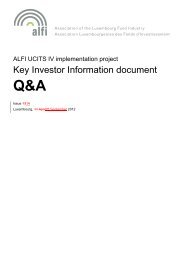Real Estate Investment Funds: Financial reporting - Alfi
Real Estate Investment Funds: Financial reporting - Alfi
Real Estate Investment Funds: Financial reporting - Alfi
Create successful ePaper yourself
Turn your PDF publications into a flip-book with our unique Google optimized e-Paper software.
accounting<br />
1. Which GAAPs are<br />
appropriate for the<br />
financial statements of<br />
a Luxembourg REIF?<br />
a. Luxembourg GAAP is common, especially<br />
for smaller closed-ended funds.<br />
b. IFRS has become more common since 2005<br />
in public interest or larger institutional funds<br />
with appropriate adjustment to arrive at a<br />
"best estimate" of the fair value of the NAV<br />
(refer to Chapter IV.1).<br />
2. How should a fund<br />
treat development<br />
property not<br />
characterised as<br />
inventory?<br />
a. Under IFRS, LuxGAAP, and INREV, property<br />
being developed as an investment property<br />
should be carried at fair value similar to<br />
properties being developed for trading purposes.<br />
b. Under IFRS, a property under development<br />
where it is intended that the completed asset is<br />
to be held to earn rental income or for capital<br />
appreciation or both is classified as an<br />
investment property under IAS 40. Assuming<br />
the fair value model is applied under IAS 40,<br />
the property under development will be<br />
measured at its fair value, unless that fair value<br />
cannot be reliably estimated in which case the<br />
asset will be measured at cost until either its fair<br />
value becomes reliably determinable or<br />
construction is completed (whichever comes<br />
earlier) after which it is measured at fair value.<br />
c. Neither LuxGAAP nor IAS 40 provide any<br />
specific guidance as to the valuation of<br />
properties under development. In practice,<br />
however, common methods found include:<br />
(i) the hypothetical developer’s method<br />
otherwise known as the "residual method" of<br />
valuation; and (ii) the discounted cash flow<br />
(DCF) method. The hypothetical developer’s<br />
method deducts costs of construction, finance<br />
and anticipated profit (a percentage of cost)<br />
from an exit value i.e., the gross development<br />
value of the completed property. The DCF<br />
approach uses (project) risk adjusted discount<br />
factors. Detailed guidelines are limited in respect<br />
of such valuations. However the European<br />
Public <strong>Real</strong> <strong>Estate</strong> Association (EPRA) and the<br />
International Valuation Standards Board (IVSB)<br />
have both released more detailed guidance on<br />
the subject. EPRA’s guidance has been released<br />
as "Valuing <strong>Investment</strong> Property under<br />
Construction, EPRA recommendations to the<br />
IVSC" released in November 2008 while the<br />
IVSB published its new "International Valuation<br />
Standards" including "IVS 233 - The Valuation<br />
of <strong>Investment</strong> Property under Construction" in<br />
July 2011.<br />
d. Where few key project milestones have been<br />
met (such as during the early stages of a<br />
development project) it may be that Fund<br />
management assess that it is not appropriate<br />
to recognise a gain above the cost of<br />
development in the property under<br />
construction when valuing an asset. In other<br />
words cost represents the fair value of the<br />
property under construction until a certain<br />
amount of the project risks have been<br />
eliminated or reduced. In any case, however,<br />
where cost is used as a proxy for fair value of<br />
a property under construction an assessment<br />
must be made as to whether the total costs of<br />
construction will exceed the fair value of the<br />
asset at completion and thus whether any<br />
write-down on the costs incurred to date is<br />
required to provide an accurate estimate of<br />
fair value of the asset.<br />
3. How should a fund<br />
treat properties held<br />
for trading purposes?<br />
a. Properties held for trading as part of a<br />
purchase, development and sales program<br />
should be treated as inventory when the<br />
developer takes the sales risk.<br />
b. Under LuxGAAP, these are treated as<br />
inventory and carried at fair value which<br />
is established as described above in<br />
Chapter III.2.c and Chapter III.2.d.<br />
c. Under IAS 2, however, they would be carried<br />
at the lower of cost and net realisable value<br />
(NRV). This means that there could be a<br />
reconciling item between IFRS financial<br />
statements and the NAV in cases where the<br />
fair value of such inventory was materially<br />
different to its cost. Such reconciling item is<br />
also in line with the INREV guidelines for<br />
the adjusted NAV calculation.<br />
d.The methodology for calculating the NRV<br />
of property under construction classified as<br />
inventory is typically determined as the<br />
selling price of the completed asset less<br />
remaining construction costs to be incurred<br />
and a provision for selling costs. This is not<br />
identical to the estimation of fair value as<br />
14

















